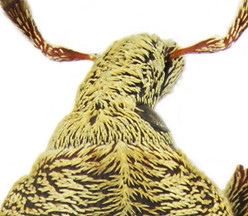top of page
Julien Haran
Key to Acallopistus species
Reference: Haran J. (2013) Revision of the genus Acallopistus Schoenherr (Coleoptera, Curculionidae, Curculioninae, Nerthopini).Zootaxa 3620(4):553-568
1

Fore-tibiae strongly elbowed in the middle, apical part not expanded......2


Fore-tibiae straight or weakly elbowed and expanded in the apical half.............................4
4
Scales on the top of rostrum oriented backward, fore-tibiae indistinctly elbowed ............................................5
Scales on the top of rostrum oriented transversely to the median line, fore-tibiae elbowed............................................................6






5
Dorsum with uniform bright yellowish scales, dense, hiding the cuticle. Pronotum without distinct dark spot.....................................A. abutilonis
Dorsum with yellowish grey scales, not concealing the integument. Pronotum with dark spot, sometimes entirely dark-brown.....................................A. vellicosus


6
Interocular space little more than half as wide as rostrum in the middle of its length...........................................7
Interocular distance as wide as rostrum in the middle of its length..............................A. fallax


7
Tooth of fore-femora with 5 to 6 denticles. Elytra with vestiture not contrasting......................A. guttatus
Tooth of fore-femora with 8 to 10 denticles. Elytra with vestiture contrasting: odd intervals dark-brown with clear white spots................................................A. dissimilis




bottom of page



